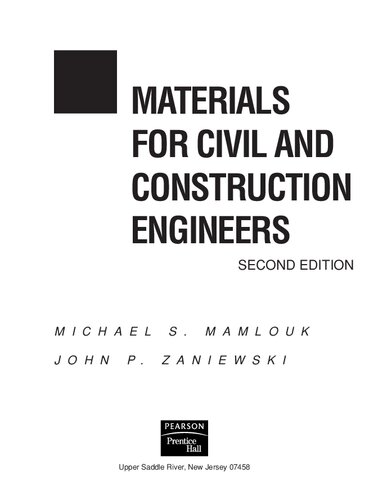(EBOOK PDF)Materials For Civil And Construction Engineers 2nd Edition by Michael Mamlouk, John Zaniewski 9780131477148 0131477145 full chapters
$50.00 Original price was: $50.00.$35.00Current price is: $35.00.
Materials For Civil And Construction Engineers 2nd Edition by Michael Mamlouk, John P. Zaniewski – Ebook PDF Instant Download/Delivery: 9780131477148, 0131477145
Full download Materials For Civil And Construction Engineers 2nd Edition after payment

Product details:
• ISBN 10:0131477145
• ISBN 13:9780131477148
• Author: Michael Mamlouk, John P. Zaniewski
Revision of the best selling civil engineering materials book on the market right now. Appropriate for civil engineering students at the junior or senior level. In the second edition, new sample problems have been added throughout the text. Many numerical problems have been added at the end of each chapter. The authors added many figures and pictures throughout the MS, especially in the appendix. The sections on Heat Treatment of Steel, Properties of Blended Aggregates, Admixtures for Concrete, Superpave Mix Design have been changed or updated. New sections on Bulk Unit Weight and Voids in Aggregate, Selef Consolidating Concrete and Flowable Fill, High-Performance Concrete have been added.
Materials For Civil And Construction Engineers 2nd Table of contents:
- 1.1 Economic Factors
- 1.2 Mechanical Properties
- 1.2.1 Loading Conditions
- 1.2.2 Stress—Strain Relations
- 1.2.3 Elastic Behavior
- 1.2.4 Elastoplastic Behavior
- 1.2.5 Viscoelastic Behavior
- 1.2.6 Temperature and Time Effects
- 1.2.7 Work and Energy
- 1.2.8 Failure and Safety
- 1.3 Nonmechanical Properties
- 1.3.1 Density and Unit Weight
- 1.3.2 Thermal Expansion
- 1.3.3 Surface Characteristics
- 1.4 Production and Construction
- 1.5 Aesthetic Characteristics
- 1.6 Sustainable Design
- 1.7 Material Variability
- 1.7.1 Sampling
- 1.7.2 Normal Distribution
- 1.7.3 Control Charts
- 1.7.4 Experimental Error
- 1.8 Laboratory Measuring Devices
- 1.8.1 Dial Gauge
- 1.8.2 Linear Variable Differential Transformer (LVDT)
- 1.8.3 Strain Gauge
- 1.8.4 Non-Contact Deformation Measurement Technique
- 1.8.5 Proving Ring
- 1.8.6 Load Cell
- Summary
- Questions and Problems
- 1.9 References
TWO Nature of Materials
- 2.1 Basic Materials Concepts
- 2.1.1 Electron Configuration
- 2.1.2 Bonding
- 2.1.3 Material Classification by Bond Type
- 2.2 Metallic Materials
- 2.2.1 Lattice Structure
- 2.2.2 Lattice Defects
- 2.2.3 Grain Structure
- 2.2.4 Alloys
- 2.2.5 Phase Diagrams
- 2.2.6 Combined Effects
- 2.3 Inorganic Solids
- 2.4 Organic Solids
- 2.4.1 Polymer Development, Structure, and Cross-Linking
- 2.4.2 Melting and Glass Transition Temperature
- 2.4.3 Mechanical Properties
- Summary
- Questions and Problems
- 2.5 References
THREE Steel
- 3.1 Steel Production
- 3.2 Iron—Carbon Phase Diagram
- 3.3 Heat Treatment of Steel
- 3.3.1 Annealing
- 3.3.2 Normalizing
- 3.3.3 Hardening
- 3.3.4 Tempering
- 3.3.5 Example of Heat Treatment
- 3.4 Steel Alloys
- 3.5 Structural Steel
- 3.5.1 Structural Steel Grades
- 3.5.2 Sectional Shapes
- 3.5.3 Specialty Steels in Structural Applications
- 3.6 Cold-Formed Steel
- 3.6.1 Cold-Formed Steel Grades
- 3.6.2 Cold-Formed Steel Shapes
- 3.6.3 Special Design Considerations for Cold-Formed Steel
- 3.7 Fastening Products
- 3.8 Reinforcing Steel
- 3.8.1 Conventional Reinforcing
- 3.8.2 Steel for Prestressed Concrete
- 3.9 Mechanical Testing of Steel
- 3.9.1 Tension Test
- 3.9.2 Torsion Test
- 3.9.3 Charpy V Notch Impact Test
- 3.9.4 Bend Test
- 3.9.5 Hardness Test
- 3.9.6 Ultrasonic Testing
- 3.10 Welding
- 3.11 Steel Corrosion
- 3.11.1 Methods for Corrosion Resistance
- 3.12 Steel Sustainability
- 3.12.1 LEED Considerations
- 3.12.2 Other Sustainability Considerations
- Summary
- Questions and Problems
- 3.13 References
FOUR Aluminum
- 4.1 Aluminum Production
- 4.2 Aluminum Metallurgy
- 4.2.1 Alloy Designation System
- 4.2.2 Temper Treatments
- 4.3 Aluminum Testing and Properties
- 4.4 Welding and Fastening
- 4.5 Corrosion
- 4.6 Aluminum Sustainability
- 4.6.1 LEED Considerations
- 4.6.2 Other Sustainability Considerations
- Summary
- Questions and Problems
- 4.7 References
FIVE Aggregates
- 5.1 Aggregate Sources
- 5.1 Aggregate Sources
- 5.2 Geological Classification
- 5.3 Evaluation of Aggregate Sources
- 5.4 Aggregate Uses
- 5.5 Aggregate Properties
- 5.5.1 Particle Shape and Surface Texture
- 5.5.2 Soundness and Durability
- 5.5.3 Toughness, Hardness, and Abrasion Resistance
- 5.5.4 Absorption
- 5.5.5 Specific Gravity
- 5.5.6 Bulk Unit Weight and Voids in Aggregate
- 5.5.7 Strength and Modulus
- 5.5.8 Gradation
- 5.5.9 Cleanness and Deleterious Materials
- 5.5.10 Alkali—Aggregate Reactivity
- 5.5.11 Affinity for Asphalt
- 5.6 Handling Aggregates
- 5.6.1 Sampling Aggregates
- 5.7 Aggregates Sustainability
- 5.7.1 LEED Considerations
- 5.7.2 Other Sustainability Considerations
- Summary
- Questions and Problems
- 5.8 References
SIX Portland Cement, Mixing Water, and Admixtures
- 6.1 Portland Cement Production
- 6.2 Chemical Composition of Portland Cement
- 6.3 Fineness of Portland Cement
- 6.4 Specific Gravity of Portland Cement
- 6.5 Hydration of Portland Cement
- 6.5.1 Structure Development in Cement Paste
- 6.5.2 Evaluation of Hydration Progress
- 6.6 Voids in Hydrated Cement
- 6.7 Properties of Hydrated Cement
- 6.7.1 Setting
- 6.7.2 Soundness
- 6.7.3 Compressive Strength of Mortar
- 6.8 Water—Cement Ratio
- 6.9 Types of Portland Cement
- 6.9.1 Standard Portland Cement Types
- 6.9.2 Other Cement Types
- 6.10 Mixing Water
- 6.10.1 Acceptable Criteria
- 6.10.2 Disposal and Reuse of Concrete Wash Water
- 6.11 Admixtures for Concrete
- 6.11.1 Air Entrainers
- 6.11.2 Water Reducers
- 6.11.3 Retarders
- 6.11.4 Hydration-Control Admixtures
- 6.11.5 Accelerators
- 6.11.6 Specialty Admixtures
- 6.12 Supplementary Cementitious Materials
- 6.13 Cement Sustainability
- 6.13.1 LEED Considerations
- 6.13.2 Other Sustainability Considerations
- Summary
- Questions and Problems
- 6.14 References
SEVEN Portland Cement Concrete
- 7.1 Proportioning of Concrete Mixes
- 7.1.1 Basic Steps for Weight and Absolute Volume Methods
- 7.1.2 Mixing Concrete for Small Jobs
- 7.2 Mixing, Placing, and Handling Fresh Concrete
- 7.2.1 Ready-Mixed Concrete
- 7.2.2 Mobile Batcher Mixed Concrete
- 7.2.3 Depositing Concrete
- 7.2.4 Pumped Concrete
- 7.2.5 Vibration of Concrete
- 7.2.6 Pitfalls and Precautions for Mixing Water
- 7.2.7 Measuring Air Content in Fresh Concrete
- 7.2.8 Spreading and Finishing Concrete
- 7.3 Curing Concrete
- 7.3.1 Ponding or Immersion
- 7.3.2 Spraying or Fogging
- 7.3.3 Wet Coverings
- 7.3.4 Impervious Papers or Plastic Sheets
- 7.3.5 Membrane-Forming Compounds
- 7.3.6 Forms Left in Place
- 7.3.7 Steam Curing
- 7.3.8 Insulating Blankets or Covers
- 7.3.9 Electrical, Hot Oil, and Infrared Curing
- 7.3.10 Curing Period
- 7.4 Properties of Hardened Concrete
- 7.4.1 Early Volume Change
- 7.4.2 Creep Properties
- 7.4.3 Permeability
- 7.4.4 Stress—Strain Relationship
- 7.5 Testing of Hardened Concrete
- 7.5.1 Compressive Strength Test
- 7.5.2 Split-Tension Test
- 7.5.3 Flexure Strength Test
- 7.5.4 Rebound Hammer Test
- 7.5.5 Penetration Resistance Test
- 7.5.6 Ultrasonic Pulse Velocity Test
- 7.5.7 Maturity Test
- 7.6 Alternatives to Conventional Concrete
- 7.6.1 Self-Consolidating Concrete
- 7.6.2 Flowable Fill
- 7.6.3 Shotcrete
- 7.6.4 Lightweight Concrete
- 7.6.5 Heavyweight Concrete
- 7.6.6 High-Strength Concrete
- 7.6.7 Shrinkage-Compensating Concrete
- 7.6.8 Polymers and Concrete
- 7.6.9 Fiber-Reinforced Concrete
- 7.6.10 Roller-Compacted Concrete
- 7.6.11 High-Performance Concrete
- 7.6.12 Pervious Concrete
- 7.7 Concrete Sustainability
- 7.7.1 LEED Considerations
- 7.7.2 Other Sustainability Considerations
- Summary
- Questions and Problems
- 7.8 References
EIGHT Masonry
- 8.1 Masonry Units
- 8.1.1 Concrete Masonry Units
- 8.1.2 Clay Bricks
- 8.2 Mortar
- 8.3 Grout
- 8.4 Plaster
- 8.5 Masonary Sustainability
- 8.5.1 LEED Considerations
- 8.5.2 Other Sustainability Consideration
- Summary
- Questions and Problems
- 8.6 References
NINE Asphalt Binders and Asphalt Mixtures
- 9.1 Types of Asphalt Cement Products
- 9.2 Uses of Asphalt
- 9.3 Temperature Susceptibility of Asphalt
- 9.4 Chemical Properties of Asphalt
- 9.5 Superpave and Performance Grade Binders
- 9.6 Characterization of Asphalt Cement
- 9.6.1 Performance Grade Characterization Approach
- 9.6.2 Performance Grade Binder Characterization
- 9.6.3 Traditional Asphalt Characterization Tests
- 9.7 Classification of Asphalt
- 9.7.1 Asphalt Binders
- 9.7.2 Asphalt Cutbacks
- 9.7.3 Asphalt Emulsions
- 9.8 Asphalt Concrete
- 9.9 Asphalt Concrete Mix Design
- 9.9.1 Specimen Preparation in the Laboratory
- 9.9.2 Density and Voids Analysis
- 9.9.3 Superpave Mix Design
- 9.9.4 Superpave Refinement
- 9.9.5 Marshall Method of Mix Design
- 9.9.6 Evaluation of Moisture Susceptibility
- 9.10 Characterization of Asphalt Concrete
- 9.10.1 Indirect Tensile Strength
- 9.10.2 Asphalt Mixture Performance Tester
- 9.11 Hot-Mix Asphalt Concrete Production and Construction
- 9.11.1 Production of Raw Materials
- 9.11.2 Manufacturing Asphalt Concrete
- 9.11.3 Field Operations
- 9.12 Recycling of Asphalt Concrete
- 9.12.1 RAP Evaluation
- 9.12.2 RAP Mix Design
- 9.12.3 RAP Production and Construction
- 9.13 Additives
- 9.13.1 Fillers
- 9.13.2 Extenders
- 9.13.3 Polymer Modified Asphalt
- 9.13.4 Antistripping Agents
- 9.13.5 Others
- 9.14 W arm Mix
- 9.15 Asphalt Sustainability
- 9.15.1 LEED Considerations
- 9.15.2 Other Sustainability Considerations
- Summary
- Questions and Problems
- 9.16 References
TEN Wood
- 10.1 Structure of Wood
- 10.1.1 Growth Rings
- 10.1.2 Anisotropic Nature of Wood
- 10.2 Chemical Composition
- 10.3 Moisture Content
- 10.4 Wood Production
- 10.4.1 Cutting Techniques
- 10.4.2 Seasoning
- 10.5 Lumber Grades
- 10.5.1 Hardwood Grades
- 10.5.2 Softwood Grades
- 10.6 Defects in Lumber
- 10.7 Physical Properties
- 10.7.1 Specific Gravity and Density
- 10.7.2 Thermal Properties
- 10.7.3 Electrical Properties
- 10.8 Mechanical Properties
- 10.8.1 Modulus of Elasticity
- 10.8.2 Strength Properties
- 10.8.3 Load Duration
- 10.8.4 Damping Capacity
- 10.9 Testing to Determine Mechanical Properties
- 10.9.1 Flexure Test of Structural Members (ASTM D198)
- 10.9.2 Flexure Test of Small, Clear Specimen (ASTM D143)
- 10.10 Design Considerations
- 10.11 Organisms that Degrade Wood
- 10.11.1 Fungi
- 10.11.2 Insects
- 10.11.3 Marine Organisms
- 10.11.4 Bacteria
- 10.12 Wood Preservation
- 10.12.1 Petroleum-Based Solutions
- 10.12.2 Waterborne Preservatives
- 10.12.3 Application Techniques
- 10.12.4 Construction Precautions
- 10.13 Engineered Wood Products
- 10.13.1 Structural Panels/Sheets
- 10.13.2 Structural Shapes
- 10.13.3 Composite Structural Members
- 10.14 Wood Sustainability
- 10.14.1 LEED Considerations
- 10.14.2 Other Sustainability Considerations
- Summary
- Questions and Problems
- 10.15 References
ELEVEN Composites
- 11.1 Microscopic Composites
- 11.1.1 Fiber-Reinforced Composites
- 11.1.2 Particle-Reinforced Composites
- 11.1.3 Matrix Phase
- 11.1.4 Fabrication
- 11.1.5 Civil Engineering Applications
- 11.2 Macroscopic Composites
- 11.2.1 Plain Portland Cement Concrete
- 11.2.2 Reinforced Portland Cement Concrete
- 11.2.3 Asphalt Concrete
- 11.2.4 Engineered Wood
- 11.3 Properties of Composites
- 11.3.1 Ductility and Strength of Composite
- 11.3.2 Modulus of Elasticity of Composite
- 11.4 Composites Sustainability
- 11.4.1 LEED Considerations
- 11.4.2 Other Sustainability Considerations
- Summary
- Questions and Problems
- 11.5 References
Appendix
Laboratory Manual
- Introduction to Measuring Devices
- Tension Test of Steel and Aluminum
- Torsion Test of Steel and Aluminum
- Impact Test of Steel
- Microscopic Inspection of Materials
- Creep in Polymers
- Sieve Analysis of Aggregates
- Specific Gravity and Absorption of Coarse Aggregate
- Specific Gravity and Absorption of Fine Aggregate
- Bulk Unit Weight and Voids in Aggregate
- Slump of Freshly Mixed Portland Cement Concrete
- Unit Weight and Yield of Freshly Mixed Concrete
- Air Content of Freshly Mixed Concrete by Pressure Method
- Air Content of Freshly Mixed Concrete by Volumetric Method
- Making and Curing Concrete Cylinders and Beams
- Capping Cylindrical Concrete Specimens with Sulfur or Capping Compound
- Compressive Strength of Cylindrical Concrete Specimens
- Flexural Strength of Concrete
- Rebound Number of Hardened Concrete
- Penetration Resistance of Hardened Concrete
- Testing of Concrete Masonry Units
- Viscosity of Asphalt Binder by Rotational Viscometer
- Dynamic Shear Rheometer Test of Asphalt Binder
- Penetration Test of Asphalt Cement
- Absolute Viscosity Test of Asphalt
- Preparing and Determining the Density of Hot-Mix Asphalt (HMA) Specimens by Means of the Superpave Gyratory Compactor
- Preparation of Asphalt Concrete Specimens Using the Marshall Compactor
- Bulk Specific Gravity of Compacted Bituminous Mixtures
- Marshall Stability and Flow of Asphalt Concrete
- Bending (Flexure) Test of Wood
- Tensile Properties of Composites
- Effect of Fiber Orientation on the Elastic Modulus of Fiber Reinforced Composites
Index
People also search for Materials For Civil And Construction Engineers 2nd:
materials for civil and construction engineers
materials for civil and construction engineers 4th
materials for civil and construction engineers 4th edition chegg
materials for civil and construction engineers fourth edition
materials for civil and construction engineers 3/e
Tags:
Materials For Civil,Construction Engineers,Michael Mamlouk, John Zaniewski



